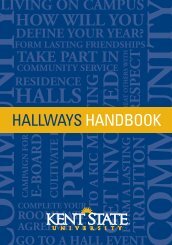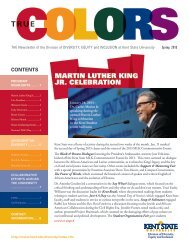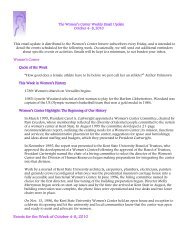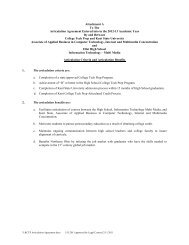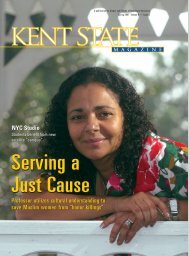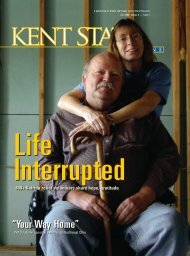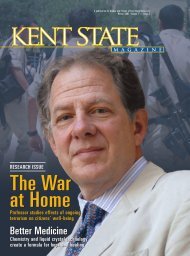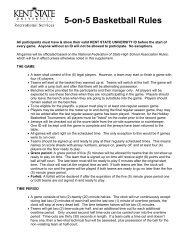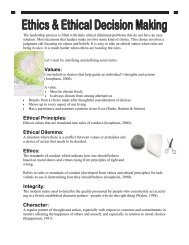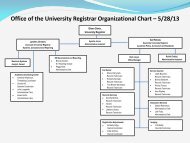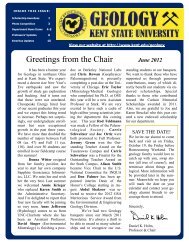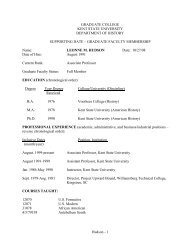Lester Lefton Lester Lefton - Kent State University
Lester Lefton Lester Lefton - Kent State University
Lester Lefton Lester Lefton - Kent State University
You also want an ePaper? Increase the reach of your titles
YUMPU automatically turns print PDFs into web optimized ePapers that Google loves.
The home of Gary Lipely, ’75, in Biloxi, after Hurricane Katrina.<br />
the solution. Please know<br />
that volunteers sometimes<br />
represent the only forward<br />
progress on the slow road to<br />
recovery. Thank you for caring<br />
and even more for doing<br />
something to help.<br />
David Carstens, ’73<br />
Mandeville, La.<br />
q<br />
As a <strong>Kent</strong> <strong>State</strong> graduate and<br />
a resident of Biloxi, Miss.,<br />
since 1985, I read your fall<br />
issue with much interest. The<br />
article about the relief volunteers<br />
was very interesting,<br />
and I just wish I knew some<br />
Ohioans were in the area so I<br />
could have welcomed them.<br />
After the storm, we relied<br />
on the generosity of others<br />
to help us recover, and one<br />
of my favorite T-shirts is a<br />
“softball 1999 MAC Eastern<br />
Division champs” shirt that<br />
someone in Ohio sent down.<br />
It makes me think of happier<br />
times and realize how<br />
fortunate we are to have so<br />
many volunteers help us in<br />
our recovery. …<br />
On this … anniversary<br />
of the storm, there is still<br />
much that needs to be done.<br />
As your article stated, most<br />
people aren’t really aware of<br />
the devastation, so we like<br />
articles like yours so people<br />
can realize that many people<br />
are still struggling. Thanks<br />
again for all the volunteers!<br />
Gary Lipely, ’75<br />
Biloxi, Miss.<br />
Countdown to<br />
Centennial<br />
The Good Old Days<br />
Nice job — the magazine!<br />
It’s inspired me (as <strong>Kent</strong>’s<br />
first journalism graduate) to<br />
write you a piece about the<br />
time I was there. It may bring<br />
up memories for some of<br />
your readers — and inform<br />
many others. Keep up the<br />
good work.<br />
(As a little old lady, pushing<br />
90, and a <strong>Kent</strong> alumna, I<br />
feel challenged to write a piece<br />
for <strong>Kent</strong> <strong>State</strong> Magazine describing<br />
<strong>Kent</strong> as it was in the<br />
good old days — 1935-39.)<br />
We had lived through the<br />
Depression, somehow, and a<br />
few of us, hoping to further<br />
our education and our eventual<br />
income, enrolled at <strong>Kent</strong>.<br />
It had been a two-year teacher<br />
education school and was<br />
now a four-year liberal arts<br />
college. I had just enough<br />
money for the tuition, but<br />
for room and board, it was<br />
a matter of waiting tables in<br />
the Lowry Hall dining room,<br />
wiping dishes in the kitchen<br />
(no machines to do it then)<br />
and working at the dormitory<br />
front desk. At that time,<br />
the New Deal had set up a<br />
student work program and<br />
the lucky ones were assigned<br />
to work in some professor’s<br />
office. I was assigned to a<br />
new young professor who<br />
was setting up the first class<br />
in journalism. I also enrolled<br />
in his class. His name was<br />
William Taylor.<br />
All students were<br />
required to attend a weekly<br />
meeting in the auditorium.<br />
Sometimes there was a<br />
performance by a student<br />
from the music department<br />
or the theatre club, but often<br />
just the president ( James<br />
O. Engleman) talking to us.<br />
We went from our dorms<br />
(there were two and just for<br />
women) to the two classroom<br />
buildings or down the hill<br />
past the Teachers College<br />
to the library. There, we<br />
might find a newspaper (the<br />
Cleveland Plain Dealer or<br />
the Akron Beacon Journal) to<br />
catch up on the news. Radios<br />
in our rooms were forbidden,<br />
although some students<br />
did have radios and secretly<br />
tuned in to the news and<br />
sometimes listened to music.<br />
All the buildings were at<br />
the top of the hill. A driveway<br />
circled up to and around<br />
in front of them and down<br />
again to the main roadway.<br />
At one corner there was Captain<br />
Brady’s where, if we had<br />
a little bit of extra money, we<br />
could buy a milkshake or a<br />
dish of ice cream. …<br />
At graduation, we walked<br />
up this hill, passing professors<br />
in their black gowns,<br />
lined up on each side of the<br />
walk. Our diplomas were<br />
handed over to us in the<br />
auditorium. I was in the first<br />
four-year liberal arts graduating<br />
class in 1939. Not so long<br />
after that — Pearl Harbor —<br />
and, of course, many of my<br />
young men classmates went<br />
to war — some never to<br />
return. …<br />
Frances Waterbury Richardson, ’39<br />
Springfield, Va.<br />
“Dinks”<br />
Check the records. I still had<br />
to “dink” in the fall of ’69.<br />
Also let’s not forget the little<br />
yellow plastic buckets given<br />
to freshmen at Prentice Hall<br />
and used to haul toiletries to<br />
the restroom/shower.<br />
Barb Wolfe Kendeigh, ’69<br />
Elyria, Ohio<br />
Online Exclusive<br />
Share your<br />
memories —<br />
and read others — online<br />
at www.kent.edu/<br />
centennialmemories.<br />
p a g e



